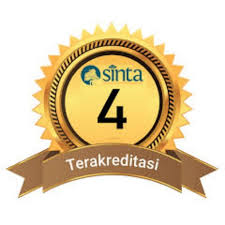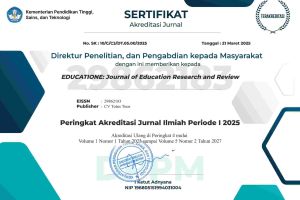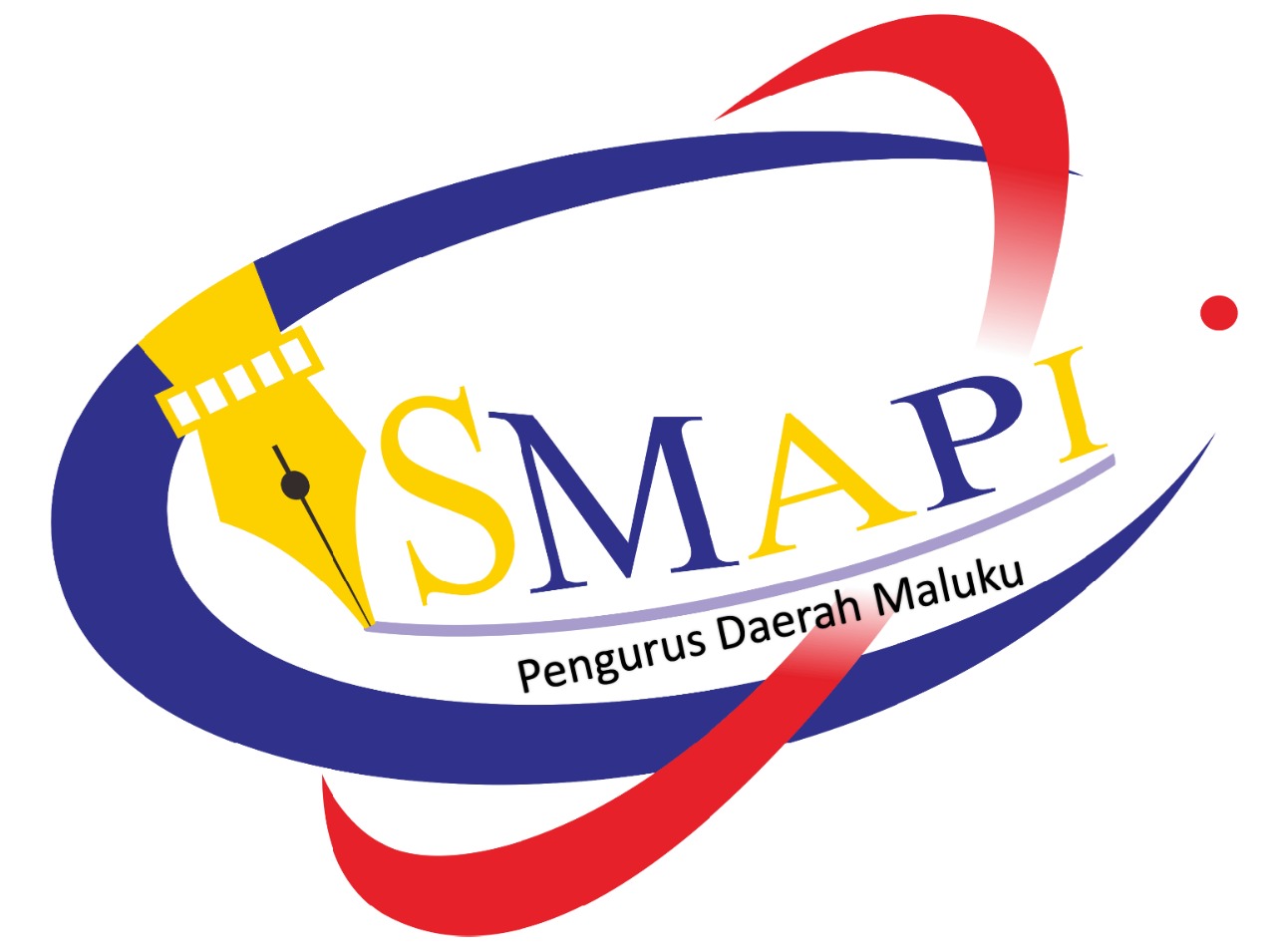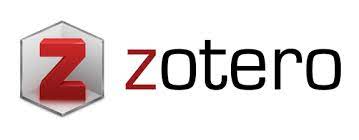User Menu
Author Guidelines
Article type
EDUCATIONE: Journal of Education Research and Review requires authors to select the appropriate article type for their manuscript and to comply with the article type descriptions defined in the journal's 'Article types' page, which can be found under the 'About journal' menu in 'For authors' on EDUCATIONE: Journal of Education Research and Review. Please pay close attention to the word count limits.
Templates
If working with Word please use our Word templates.
During the interactive review, authors are encouraged to upload versions using track changes. Editors and reviewers can only download the PDF/DOC file of the submitted manuscript.
Manuscript length
We encourage you to closely follow the article word count lengths given in the 'Article types' page of the journals. The manuscript length includes only the main body of the text, footnotes, and all citations within it, and excludes the abstract, section titles, figure and table captions, funding statement, acknowledgments, and references in the bibliography. Please indicate the number of words and the number of figures and tables included in your manuscript on the first page.
Language editing
EDUCATIONE: Journal of Education Research and Review requires manuscripts submitted to meet international English language standards to be considered for publication.
For authors who would like their manuscript to receive language editing or proofreading to improve the clarity of the manuscript and help highlight their research, we recommend the language-editing services provided by the following external partners.
Note that sending your manuscript for language editing does not imply or guarantee that it will be accepted for publication by a EDUCATIONE: Journal of Education Research and Review. Editorial decisions on the scientific content of a manuscript are independent of whether it has received language editing or proofreading by these partner services or other services.
Editage
EDUCATIONE: Journal of Education Research and Review recommends the language-editing service provided by our external partner Editage. These services may be particularly useful for researchers for whom English is not the primary language. They can help to improve the grammar, syntax, and flow of your manuscript prior to submission.
Language style
The default language style at EDUCATIONE: Journal of Education Research and Review is American English. If you prefer your article to be formatted in British English, please specify this on the first page of your manuscript. For any questions regarding style, EDUCATIONE: Journal of Education Research and Review recommends authors to consult the APA Manual of Style.
Search engine optimization (SEO)
There are a few simple ways to maximize your article's discoverability and search results.
- Include a few of your article's keywords in the title of the article
- Do not use long article titles
- Pick 5-8 keywords using a mix of generic and more specific terms on the article subject(s)
- Use the maximum amount of keywords in the first two sentences of the abstract
- Use some of the keywords in level 1 headings
Title
The title should be concise, omitting terms that are implicit and, where possible, be a statement of the main result or conclusion presented in the manuscript. Abbreviations should be avoided within the title.
Witty or creative titles are welcome, but only if relevant and within measure. Consider if a title meant to be thought-provoking might be misinterpreted as offensive or alarming. In extreme cases, the editorial office may veto a title and propose an alternative.
Authors should avoid:
- titles that are a mere question without giving the answer
- unambitious titles, for example starting with 'Towards,' 'A description of,' 'A characterization of' or 'Preliminary study on'
- vague titles, for example starting with 'Role of', 'Link between', or 'Effect of' that do not specify the role, link, or effect
- including terms that are out of place, for example the taxonomic affiliation apart from species name.
For Corrigenda, General Commentaries, and Editorials, the title of your manuscript should have the following format.
- 'Corrigendum: [Title of original article]'
- General Commentaries:
'Commentary: [Title of original article]'
'Response: Commentary: [Title of original article]' - 'Editorial: [Title of Research Topic]'
Authors and affiliations
All names are listed together and separated by commas. Provide exact and correct author names as these will be indexed in official archives. Affiliations should be keyed to the author's name with superscript numbers and be listed as follows:
- Laboratory, Institute, Department, Organization, City, State abbreviation (only for United States, Canada, and Australia), and Country (without detailed address information such as city zip codes or street names).
Example: Max Maximus1
1 Department of Excellence, International University of Science, New York, NY, United States.
Correspondence
The corresponding author(s) should be marked with an asterisk in the author list. Provide the exact contact email address of the corresponding author(s) in a separate section.
Example: Max Maximus*
maximus@iuscience.edu
If any authors wish to include a change of address, list the present address(es) below the correspondence details using a unique superscript symbol keyed to the author(s) in the author list.
Equal contributions
The authors who have contributed equally should be marked with a symbol (†) in the author list of the doc/latex and pdf files of the manuscript uploaded at submission.
Please use the appropriate standard statement(s) to indicate equal contributions:
- Equal contribution: These authors contributed equally to this work
- First authorship: These authors share first authorship
- Senior authorship: These authors share senior authorship
- Last authorship: These authors share last authorship
- Equal contribution and first authorship: These authors contributed equally to this work and share first authorship
- Equal contribution and senior authorship: These authors contributed equally to this work and share senior authorship
- Equal contribution and last authorship: These authors contributed equally to this work and share last authorship
Example: Max Maximus 1†, John Smith2† and Barbara Smith1
†These authors contributed equally to this work and share first authorship
Consortium/group and collaborative authors
Consortium/group authorship should be listed in the manuscript with the other author(s).
In cases where authorship is retained by the consortium/group, the consortium/group should be listed as an author separated by a comma or 'and'. The consortium/group name will appear in the author list, in the citation, and in the copyright. If provided, the consortium/group members will be listed in a separate section at the end of the article.
For the collaborators of the consortium/group to be indexed in PubMed, they do not have to be inserted in the EDUCATIONE: Journal of Education Research and Review submission system individually. However, in the manuscript itself, provide a section with the name of the consortium/group as the heading followed by the list of collaborators, so they can be tagged accordingly and indexed properly.
Example: John Smith, Barbara Smith and The Collaborative Working Group.
In cases where work is presented by the author(s) on behalf of a consortium/group, it should be included in the author list separated with the wording 'for' or 'on behalf of.' The consortium/group will not retain authorship and will only appear in the author list.
Example: John Smith and Barbara Smith on behalf of The Collaborative Working Group.
Artificial intelligence
These guidelines cover acceptable uses of generative AI technologies such as Large Language Models (ChatGPT, Jasper) and text-to-image generators (DALL-E 2, Midjourney, Stable Diffusion) in the writing or editing of manuscripts submitted to EDUCATIONE: Journal of Education Research and Review.
AI use by authors
Authors should not list a generative AI technology as a co-author or author of any submitted manuscript. Generative AI technologies cannot be held accountable for all aspects of a manuscript and consequently do not meet the criteria required for authorship.
If the author of a submitted manuscript has used written or visual content produced by or edited using a generative AI technology, this use must follow all EDUCATIONE: Journal of Education Research and Review guidelines and policies. Specifically, the author is responsible for checking the factual accuracy of any content created by the generative AI technology. This includes, but is not limited to, any quotes, citations or references. Figures produced by or edited using a generative AI technology must be checked to ensure they accurately reflect the data presented in the manuscript. Authors must also check that any written or visual content produced by or edited using a generative AI technology is free from plagiarism.
If the author of a submitted manuscript has used written or visual content produced by or edited using a generative AI technology, such use must be acknowledged in the acknowledgements section of the manuscript and the methods section if applicable. This explanation must list the name, version, model, and source of the generative AI technology.
We encourage authors to upload all input prompts provided to a generative AI technology and outputs received from a generative AI technology in the supplementary files for the manuscript.
Abstract
As a primary goal, the abstract should make the general significance and conceptual advance of the work clearly accessible to a broad readership. The abstract should be no longer than a single paragraph and should be structured. For the specific structure of the abstract, authors should follow the requirements of the article type or journal to which they're submitting. Minimize the use of abbreviations and do not cite references, figures or tables.
For clinical trial articles, please include the unique identifier and the URL of the publicly-accessible website on which the trial is registered.
Keywords
All article types require a minimum of three and a maximum of five keywords.
Text
The entire document should be single-spaced and must contain page and line numbers in order to facilitate the review process. The manuscript should be written using either Word or LaTeX. See above for templates.
Nomenclature
The use of abbreviations should be kept to a minimum. Non-standard abbreviations should be avoided unless they appear at least four times, and must be defined upon first use in the main text. Consider also giving a list of non-standard abbreviations at the end, immediately before the acknowledgments.
Equations should be inserted in editable format from the equation editor.
We encourage the use of Standard International Units in all manuscripts.
Sections
The manuscript is organized by headings and subheadings. The section headings should be those appropriate for your field and the research itself. You may insert up to 5 heading levels into your manuscript (i.e.,: 3.2.2.1.2 Heading Title).
For Original Research articles, it is recommended to organize your manuscript in the following sections or their equivalents for your field.
Introduction
Succinct, with no subheadings.
Method
This section may be divided by subheadings and should contain sufficient detail so that when read in conjunction with cited references, all procedures can be repeated. For experiments reporting results on animal or human subject research, an ethics approval statement should be included in this section.
Results and Discussion
This section may be divided by subheadings. Footnotes should not be used and must be transferred to the main text. This section may be divided by subheadings. Discussions should cover the key findings of the study: discuss any prior research related to the subject to place the novelty of the discovery in the appropriate context, discuss the potential shortcomings and limitations on their interpretations, discuss their integration into the current understanding of the problem and how this advances the current views, speculate on the future direction of the research, and freely postulate theories that could be tested in the future.
For further information, please check the descriptions defined in the journal's 'Article types' page, in the 'For authors' menu on every journal page.
Acknowledgements
This is a short text to acknowledge the contributions of specific colleagues, institutions, or agencies that aided the efforts of the authors. Should the content of the manuscript have previously appeared online, such as in a thesis or preprint, this should be mentioned here, in addition to listing the source within the reference list.
Figure and table guidelines
CC-BY license
All figures, tables, and images will be published under a Creative Commons CC-BY license, and permission must be obtained for use of copyrighted material from other sources (including re-published/adapted/modified/partial figures and images from the internet). It is the responsibility of the authors to acquire the licenses, follow any citation instructions requested by third-party rights holders, and cover any supplementary charges.
Figure requirements and style guidelines
EDUCATIONE: Journal of Education Research and Review requires figures to be submitted individually, in the same order as they are referred to in the manuscript; the figures will then be automatically embedded at the end of the submitted manuscript. Kindly ensure that each figure is mentioned in the text and in numerical order.
For figures with more than one panel, panels should be clearly indicated using labels (A), (B), (C), (D), etc. However, do not embed the part labels over any part of the image, these labels will be replaced during typesetting according to EDUCATIONE: Journal of Education Research and Review style. For graphs, there must be a self-explanatory label (including units) along each axis.
Captions
Captions should be preceded by the appropriate label, for example 'Figure 1.' Figure captions should be placed at the end of the manuscript. Figure panels are referred to by bold capital letters in brackets: (A), (B), (C), (D), etc.
Image size and resolution requirements
Figures should be prepared with the PDF layout in mind. Individual figures should not be longer than one page and with a width that corresponds to 1 column (85 mm) or 2 columns (180 mm).
All images must have a resolution of 300 dpi at final size. Check the resolution of your figure by enlarging it to 150%. If the image appears blurry, jagged, or has a stair-stepped effect, the resolution is too low.
The text should be legible and of high quality. The smallest visible text should be no less than eight points in height when viewed at actual size.
Solid lines should not be broken up. Any lines in the graphic should be no smaller than two points wide.
Please note that saving a figure directly as an image file (JPEG, TIF) can greatly affect the resolution of your image. To avoid this, one option is to export the file as PDF, then convert into TIFF or EPS using a graphics software.
Format and color image mode
The following formats are accepted: TIF/TIFF (.tif/.tiff), JPEG (.jpg), and EPS (.eps) (upon acceptance). Images must be submitted in the color mode RGB.
Table requirements and style guidelines
Tables should be inserted at the end of the manuscript in an editable format. If you use a word processor, build your table in Word. If you use a LaTeX processor, build your table in LaTeX. An empty line should be left before and after the table.
Table captions must be placed immediately before the table. Captions should be preceded by the appropriate label, for example 'Table 1.' Please use only a single paragraph for the caption.
Ensure that each table is mentioned in the text and in numerical order.
Large tables covering several pages cannot be included in the final PDF for formatting reasons. These tables will be published as supplementary material.
Tables which are not according to the above guidelines will cause substantial delay during the production process.
Accessibility
We encourage authors to make the figures and visual elements of their articles accessible for the visually impaired. An effective use of color can help people with low visual acuity, or color blindness, understand all the content of an article.
Ensure sufficient contrast between text and its background
People who have low visual acuity or color blindness could find it difficult to read text with low contrast background color. Try using colors that provide maximum contrast.
WC3 recommends the following contrast ratio levels:
- Level AA, contrast ratio of at least 4.5:1
- Level AAA, contrast ratio of at least 7:1
Avoid using red or green indicators
More than 99% of color-blind people have a red-green color vision deficiency.
Avoid using only color to communicate information
Elements with complex information like charts and graphs can be hard to read when only color is used to distinguish the data. Try to use other visual aspects to communicate information, such as shape, labels, and size. Incorporating patterns into the shape fills also make differences clearer; for an example please see below:
Supplementary material
Data that are not of primary importance to the text, or which cannot be included in the article because they are too large or the current format does not permit it (such as videos, raw data traces, and PowerPoint presentations), can be uploaded as supplementary material during the submission procedure and will be displayed along with the published article. All supplementary files are deposited to figshare for permanent storage and receive a DOI.
Supplementary material is not typeset, so please ensure that all information is clearly presented without tracked changes/highlighted text/line numbers, and the appropriate caption is included in the file. To avoid discrepancies between the published article and the supplementary material, please do not add the title, author list, affiliations or correspondence in the supplementary files.
The supplementary material can be uploaded as:
- data sheet (Word, Excel, CSV, CDX, FASTA, PDF or Zip files)
- presentation (PowerPoint, PDF or Zip files)
- image (CDX, EPS, JPEG, PDF, PNG or TIF/TIFF),
- table (Word, Excel, CSV or PDF)
- audio (MP3, WAV or WMA)
- video (AVI, DIVX, FLV, MOV, MP4, MPEG, MPG or WMV).
Technical requirements for supplementary images:
- 300 DPIs
- RGB color mode.
References
Submissions to EDUCATIONE: Journal of Education Research and Review must be grounded in relevant and up to date peer-reviewed, academic research, and this should be reflected in the accompanying reference lists.
Authors are welcome to use online referencing tools in preparation of their manuscript. Some useful resources include RefMe, Zotero, and Mendeley.
- The citation of non-academic and non-peer-reviewed sources (e.g. blog posts, website content), as well as anonymous sources or commercial websites should be avoided or kept to a minimum
- Authors should avoid citing content that is not directly relevant to the scope of the article and the journal
- Reference lists should reflect the current status of knowledge in the field, avoid bias, and not include a high proportion of citations to the same authors or sources, school of thought, etc.
- The length of the reference list should be appropriate depending on the article type, covering the relevant literature through sufficient referencing
- Authors should ensure that references are accurate, that all links are accessible, and that the citations/references adhere to the reference styles outlined below
EDUCATIONE: Journal of Education Research and Review use APA reference styles. These formats should be adhered to for the in-text citations and the reference lists.
- All citations of published works in the text, figures, or tables must be in the reference list and vice-versa.
- The names of the first six authors followed by et al. and the DOI (when available) should be provided.
- Given names of authors should be abbreviated to initials (e.g. Smith, J., Lewis, C.S., etc.).
- The reference list should only include articles that are published or accepted.
- Unpublished data, submitted manuscripts, or personal communications should be cited within the text only, for article types that allow such inclusions. Where additional details are available, these will be included as footnotes.
- For accepted but unpublished works use 'in press' instead of page numbers.
- Data sets that have been deposited to an online repository should be included in the reference list. Include the version and unique identifier when available.
- Personal communications should be documented by a letter of permission.
- Website URLs should be included as footnotes.
- Any inclusion of verbatim text must be contained in quotation marks and should clearly reference the original source.
- Preprints can be cited provided that a DOI or archive URL is available, and the citation clearly mentions that the contribution is a preprint. If a peer-reviewed journal publication for the same preprint exists, the official journal publication is the preferred source. See the preprints section for each reference style below for more information


















